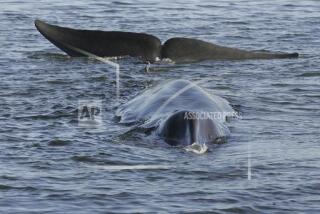Icelandair Moves Further Into Europe Market : Aviation: Airline that made its mark in 1960s with cheap Atlantic flights is looking more to the east.
- Share via
REYKJAVIK, Iceland — Icelandair, once the hippie airline that gave thousands of 1960s Americans--including a long-haired Bill Clinton--their first taste of international travel, has changed course to carve itself a slice of the new Europe.
Tiny by comparison with European and U.S. competitors, Icelandair is using its biggest advantage--a home base on an island perched halfway between the new and old worlds.
“In the last few years, we have changed strategy, from being mainly a North Atlantic carrier to mainly an Iceland-Europe carrier,” Icelandair President Sigurdir Helgason said in an interview at the carrier’s Reykjavik headquarters.
With a fleet of just 11 planes, Icelandair is no threat to other airlines, but its reputation as a low-cost bridge between Europe and the U.S. gave it breathing space in the 1970s and 80s, when other airlines were suffocating.
Now, with European aviation regulations loosening, Icelandair is dipping its toe into intra-European flights. It launched a daily flight between Copenhagen, Denmark, and Hamburg, Germany, when Iceland won the right to fly on most European routes.
The U.S.-Europe bridge strategy is still vital for Icelandair’s survival, however, and the end of the Cold War has had an undesired effect on its operations.
Keflavik Airport, some 25 miles from the Icelandic capital, has since World War II doubled as a U.S. air base, acting as a staging post for most U.S. military aircraft traveling into and out of Europe.
With the demise of Communism, the U.S. jets that screamed into the air from Keflavik to warn of possible nuclear attacks and to ward off Soviet spy planes have been returned to their U.S. bases.
The sprawling Keflavik base, once crawling with U.S. military personnel, is now home to just four F-16 fighters and the occasional transport plane.
The Keflavik runway is one of the longest in the world and is open year-round, despite Iceland’s arctic position, thanks to U.S. military snow-clearing equipment.
The equipment is still there, but Icelandair worries that the remaining U.S. jets could be sent home.
Gone are the days when tired travelers arrived in a ramshackle military base to transit on to Europe.
Icelandair’s new terminal ensures travelers have less than 50 yards to walk to join their Europe- or U.S.-bound flight, a distance planners at sprawling airports in London, Paris or Amsterdam would envy.
The company, which is listed on the sleepy Reykjavik stock exchange, has tailored its aircraft to meet its demands, and it now has one of the youngest fleets in the world, with an average age of two years.
Its three Boeing 757s fly U.S.-to-Europe routes, spending up to 16 hours a day in the air. Four Boeing 737-400s are used on intra-European and Europe-Iceland flights and Fokker 50s fly on domestic Icelandic routes.
Helgason said Icelandair was not looking at dramatic fleet expansion, but would need to purchase one new jet in the next two to three years as it pursues a target of achieving 15% of revenue from intra-European routes.
He said the company expects to turn a profit in 1994 after two years of losses because of a major coup this year in signing up the main Scandinavian tour operators for flights to Florida, one of its four East Coast destinations.
Icelandair’s freight operations, consisting mainly of fresh fish shipments to the U.S. and Europe, have risen 25% so far in 1994 and passenger-load factors are expected to rise sharply this winter.
A 10% increase in foreign tourists visiting Iceland in the past two years has also helped, he added.
Helgason said Icelandair was looking at routes out of Glasgow, Scotland, “because every time we fly to London our planes fly over it,” and was also studying other European routes.
For the moment, Icelandair has developed profitable ties with Scandinavian Airline Systems (SAS), linking its timetables to fit in with SAS flights from southern Europe to both airlines’ hub in Copenhagen.
More to Read
Sign up for Essential California
The most important California stories and recommendations in your inbox every morning.
You may occasionally receive promotional content from the Los Angeles Times.












